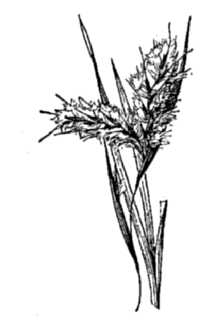Andropogon virginicus L. var. glaucus Hack.
Scientific Name: Andropogon virginicus L. var. glaucus Hack.

| General Information | |
|---|---|
| Usda Symbol | ANVIG2 |
| Group | Monocot |
| Life Cycle | Perennial |
| Growth Habits | Graminoid |
| Native Locations | ANVIG2 |
Plant Guide
Uses
Chalky bluestem is a palatable grass. It furnishes excellent spring grazing and produces high-quality winter forage. This grass establishes naturally on muckland soils that have been idle for 1 to 2 years, making it a valuable grass for protecting these soils against erosion. It is an indicator of past grazing use.
Status
Please consult the PLANTS Web site and your State Department of Natural Resources for this plant’s current status, such as, state noxious status, and wetland indicator values, Use soil moisture sensors to measure the soil moisture of Andropogon virginicus L. var. glaucus Hack..,
Description
Chalky bluestem is a warm-season, perennial bunch grass. The height is between 3 and 5 feet. The leaf blade is folded tightly; keeled at base but flattened toward tip; lower blade is 20 to 25 inches long and 1/2 inch wide. The leaf sheath is keeled, overlapping and crowded at base. The ligule has a membrane 1/16-inch long. The seedhead is raceme partly enclosed in purplish-brown spathe about 1 inch long. Line drawing reprinted from Hitchcock, A.S. 1950. Manual of the grasses of the United States. USDA Misc. Pub. No. 200, U.S. Gov. Printing Office, Washington, D.C.
Management
Since this grass seldom contributes more than 10 to 15 percent of total herbage on any site, it is seldom selected as a key management species. It maintains itself in the plant composition of grazable woodlands if grazing is deferred every summer and proper grazing is practiced during winter. Under good management, it is one of the first grasses to become established on a range that has been overgrazed. Annual burning reduces stand.
Establishment
Growth starts in mid-January in southern Florida and 30 to 45 days later in northern part of range. Vigorous plants produce leaves 8 to 10 inches long in 30 days. Stems, blades, and sheaths are covered with a white chalky coating that rubs off easily. Seedheads appear in September and early October. Seed ripen in October and November. Chalky bluestem is a good seed producer. Basal leaves stay green during winter unless temperature falls below 20' F. Particularly well adapted to wet acid or neutral sandy soils. Makes maximum growth on seepy slopes. Cultivars, Improved and Selected Materials (and area of origin) Please contact your local NRCS Field Office.
References
Frandsen, W. 1960. Grass makes its own food. United States Department of Agriculture Information Bulletin. 223 pp. Gates, F. 1937. Grasses in Kansas. Kansas State Bd. Agriculture Report. 220-A. 55: Pp. 349. Gay, C. & D. Dwyer 1965. New Mexico grasses. New Mexico State University. Circ. 374. 85 pp. Hitchcock, A. 1950. Manual of the grasses of the United States. 2nd Ed. Revised by Agnes Chase. United States Department of Agriculture Misc. Pub. 200. 1051 pp. Hoffman, G. & B. Ragsdale [n.d.]. Know your grasses. Texas A & M University Agriculture Extension Service Bulletin. 182 (Rev.). 48 pp. Judd, I. 1962. Principal forage plants of southwestern ranges. United States Department of Agriculture Forest Service. Leithead, H.L, L.L. Yarlett, & T.N. Shiflet. February 1971. 100 native forage grasses in 11 southern states. USDA SCS Agriculture Handbook No. 389, Washington, D.C. 216p. Rechenthin, C. A. 1956. Elementary morphology of grass growth and how it affects utilization. J.
